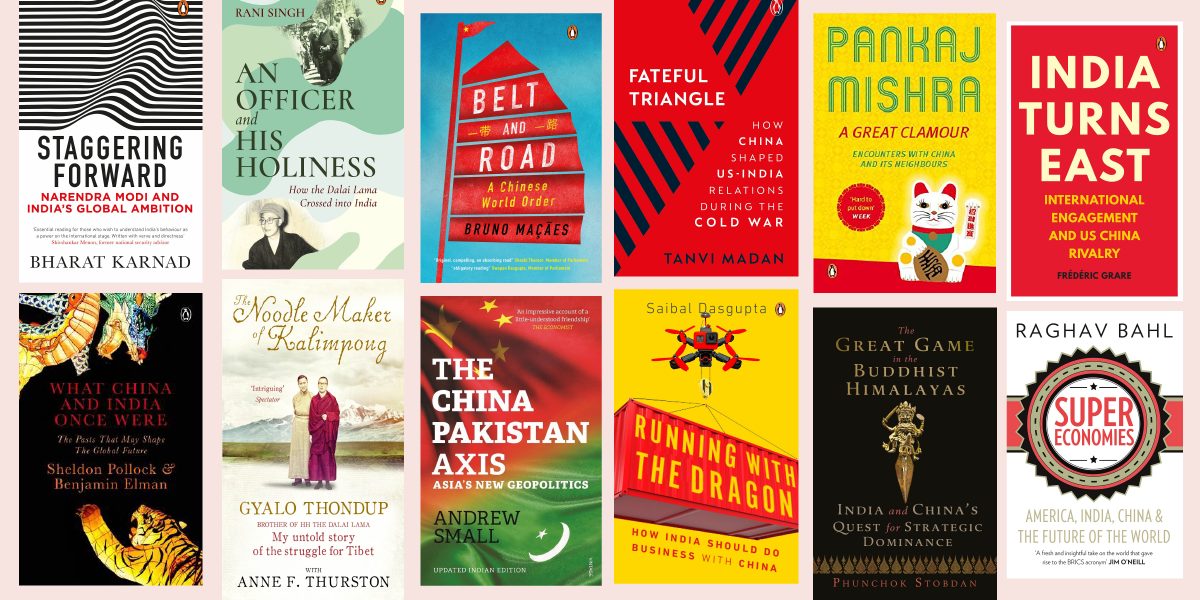
There has been constant conflict on the Indo-China frontier for many years. As Indian troops face a standoff with the Chinese along the Indo-Tibetan border, it’s a good time to better understand the genesis of this conflict between the two countries.
We’ve put together a list of books by various authors to help you understand this relationship better.
What China and India Once Were – The Pasts That May Shape the Global Future

In the early years of the twenty-first century, China and India have emerged as world powers. In many respects, this is a return to the historical norm for both countries. For much of the early modern period, China and India were global leaders in a variety of ways. In this book, prominent scholars seek to understand modern China and India through an unprecedented comparative analysis of their long histories. Using new sources, making new connections, and reexamining old assumptions, noted scholars of China and India pair up in each chapter to tackle major questions by combining their expertise.
*
Super Economies: America, India, China and the Future of the World

With its demographic advantage, a surplus of skilled labour, a potentially rising GDP, a strategic geographic location and a new, decisive political leadership, India has every chance of becoming the third Super Economy after the USA and China. Drawing on history, current affairs and political and economic analyses, Super Economies projects how India can soon become a world leader and help secure a future of peace and prosperity for all.
*
India Turns East: International Engagement and US-China Rivalry

India Turns East tells the story of India’s long and difficult journey to reclaim its status in a rapidly changing Asian environment increasingly shaped by the US–China rivalry and the uncertainties of US commitment to Asia’s security. The Look East policy initially aimed at reconnecting India with Asia’s economic globalization. As China became more assertive, Look East rapidly evolved into a comprehensive strategy with political and military dimensions.
*
India & China: The Battle Between Soft & Hard Power

India and China focuses on these two countries, both in the middle stages of market-led development and grappling with the problem that societies have faced since the dawn of capitalism- reconciling equity with the claim that free markets are not just efficient but just. The author charts out trajectories for both China and India.
*
A Great Clamour: Encounters with China and its Neighbours

Full of unexpected ideas and fresh insights, A Great Clamour is an extraordinary account of contemporary Asia from one of our finest essayists. Journeying through China, Tibet, Mongolia, Taiwan, Indonesia, Malaysia and Japan, Mishra explores the contradictions and dynamism of modern-day China, simultaneously drawing a vivid portrait of its neighbours and the shadow the restless giant casts over its stage.
*
The Great Game in the Buddhist Himalayas: India and China’s Quest for Strategic Dominance

The Great Game in the Buddhist Himalayas includes several unknown insights into the India-China, India-Tibet and China-Tibet relationships. It reads like a geopolitical thriller, taking the reader through the intricacies of reincarnation politics, competing spheres of sacred influence, and monastic and sectarian allegiances that will keep the Himalayas on edge for years to come.
*
Fateful Triangle: How China Shaped US-India Relations During the Cold War

A key question today is whether India and the United States can or should develop ever-closer ties as a way of countering China’s desire to be the dominant power in the broader Asian region. In Fateful Triangle, Tanvi Madan argues that history shows that such a partnership is neither inevitable nor impossible. Fateful Triangle updates our understanding of the diplomatic history of US-India relations, highlighting China’s central role in it, reassesses the origins and practice of Indian foreign policy and non-alignment, and provides historical context to the interactions between the three countries.
*
Running with the Dragon: How India Should Do Business with China

Running with the Dragon seeks answers about what Chinese companies are likely to do next to expand in the Indian market under different scenarios. Things are likely to change as the government is keen on removing stumbling blocks for Chinese investments amidst a decelerating economy. Indian businesses in different sectors will have to decide if they want to fight the new competition or collaborate with rivals. The book reflects the experience of over forty Indian and Chinese businesspeople, officials and experts besides the author’s own analysis.
*
Belt and Road: A Chinese World Order

China’s Belt and Road strategy is acknowledged to be the most ambitious geopolitical initiative of the age. Covering almost seventy countries by land and sea, it will affect every element of global society from shipping to agriculture, digital economy to tourism and politics to culture. Most importantly, it symbolizes a new phase in China’s ambitions as a superpower: to remake the world economy and crown Beijing as the new centre of capitalism and globalization.
Bruno Macaes traces this extraordinary initiative’s history, highlighting its achievements to date and its staggering complexity.
*
The China – Pakistan Axis: Asia’s New Geopolitics

China and Pakistan, India’s two most powerful neighbours, share an ‘all-weather’ relationship that is as reputed for its depth as it is layered in secrecy. Based on years of research and interviews, Andrew Small has put together the story of China and Pakistan’s growing, and in parts troubled, friendship.
Essential reading to understand the economic, political and security map of Asia, especially India’s neighbourhood.
*
The Noodle Maker of Kalimpong: My Untold Story of the Struggle for Tibet

For over half a century, noodlemaker Gyalo Thondup has been a familiar figure in the Himalayan hill town of Kalimpong. But it was not until 2010 that the townsfolk discovered his true identity: Gyalo Thondup is none other than the older brother of the Dalai Lama and his special envoy, a trusted interlocutor between Tibet and foreign leaders from Chiang Kai-shek to Jawaharlal Nehru, Zhou Enlai to Deng Xiaoping. Indeed, only the Dalai Lama himself has played a more important role in the political history of modern, tragedy-ridden Tibet.
Now, for the first time, Gyalo Thondup is prepared to tell his story.
*
An Officer and His Holiness

In 1959, the Dalai Lama escaped from Tibet into India, where he was granted refuge. Few know about the carefully calibrated operation to escort him safely from the Indian border. An Officer and His Holinessnarrates how political officer Har Mander Singh successfully managed this assignment in the North East Frontier Agency (NEFA) with limited resources, and despite a treacherous terrain and external threats.
Har Mander Singh kept careful diary entries of the period, which have been reproduced for the first time in this book.
*
Staggering Forward: Narendra Modi and India’s Global Ambition

Analysing Prime Minister Modi’s foreign and military policies in the context of India’s evolving socio-political and economic milieu, this book offers a critical perspective that helps explain why India has not progressed much towards becoming a consequential power. Argumentative and thought-provoking, Staggering Forward is a must-read to understand India’s foreign and national security policies since 2014.









